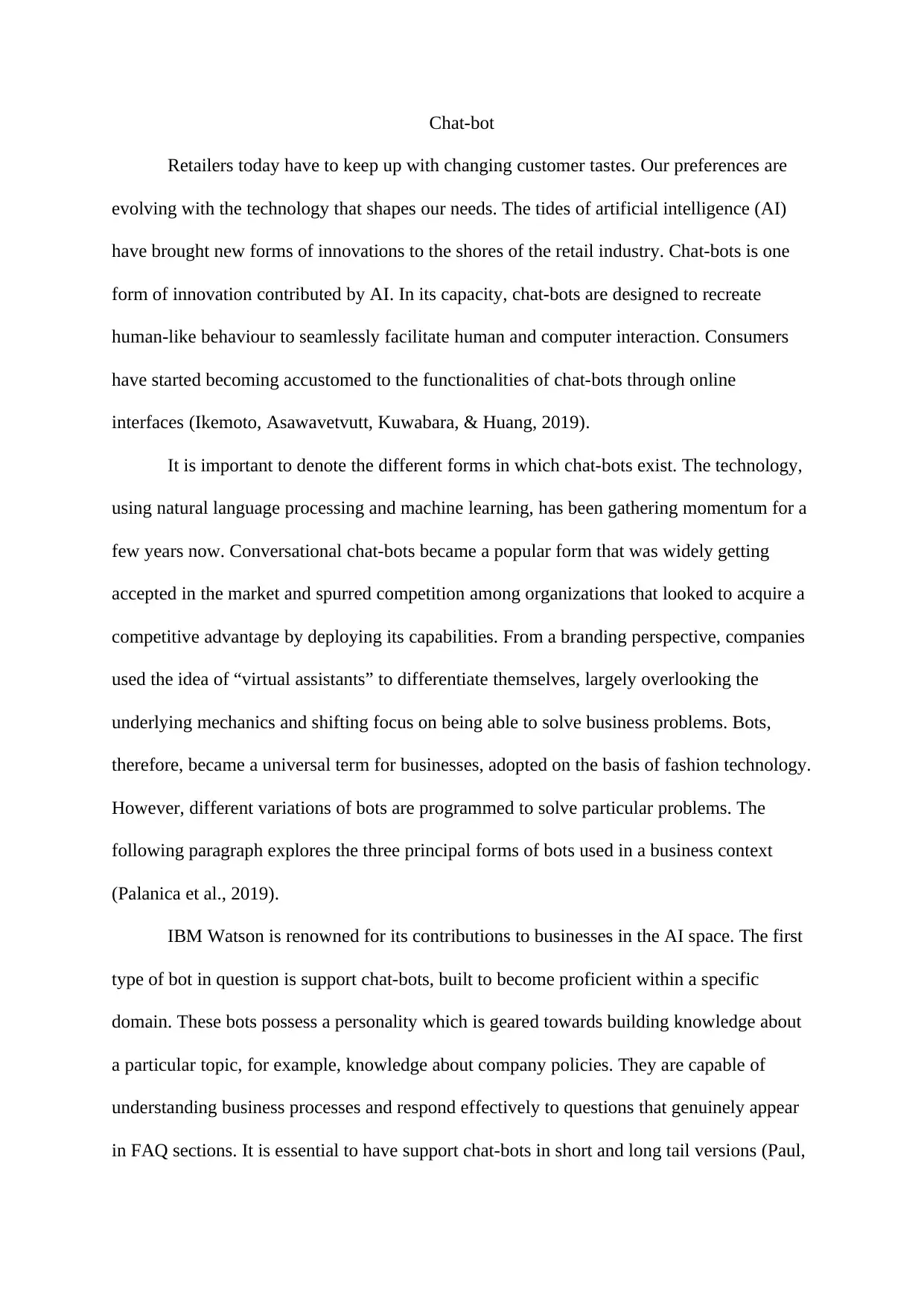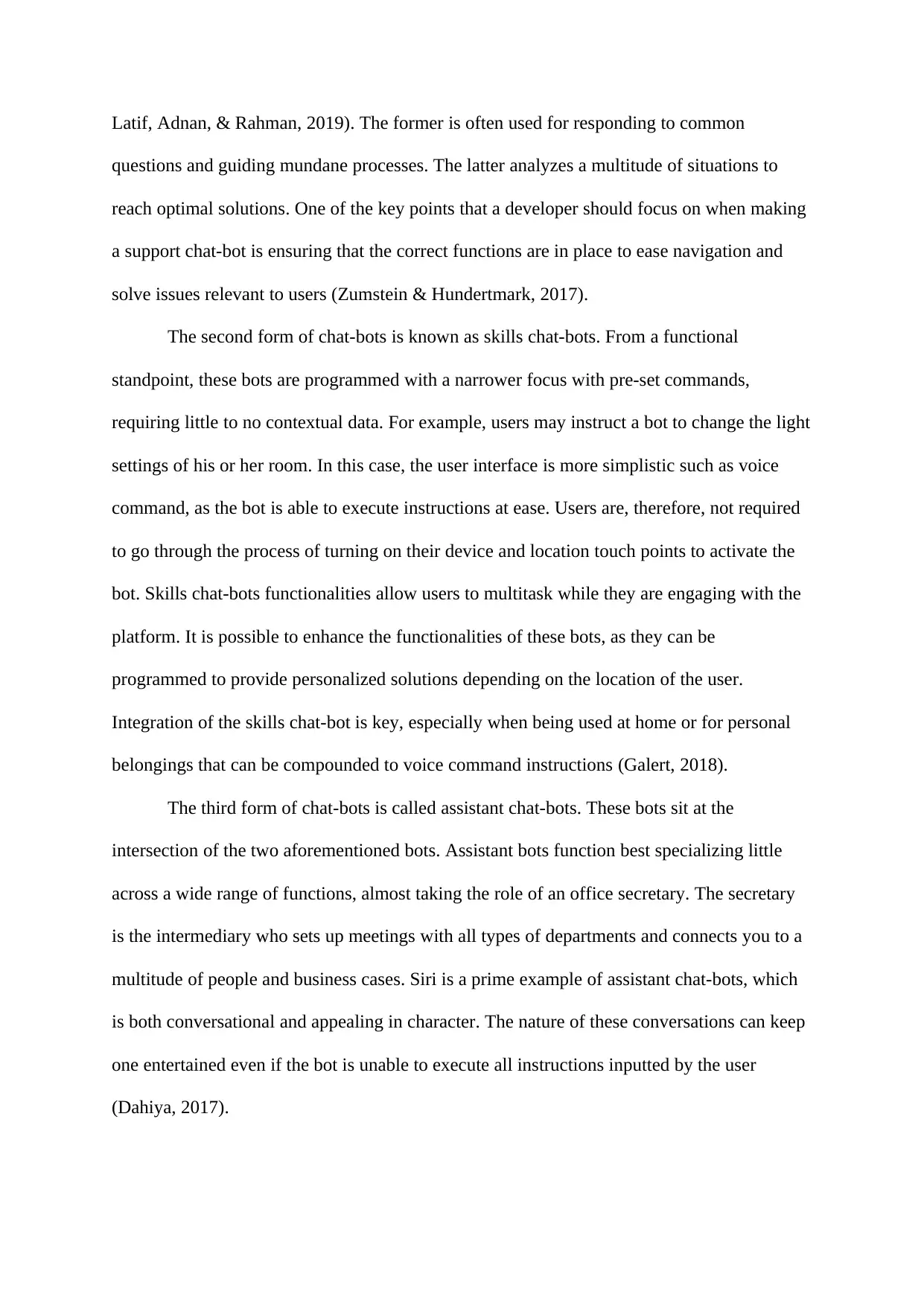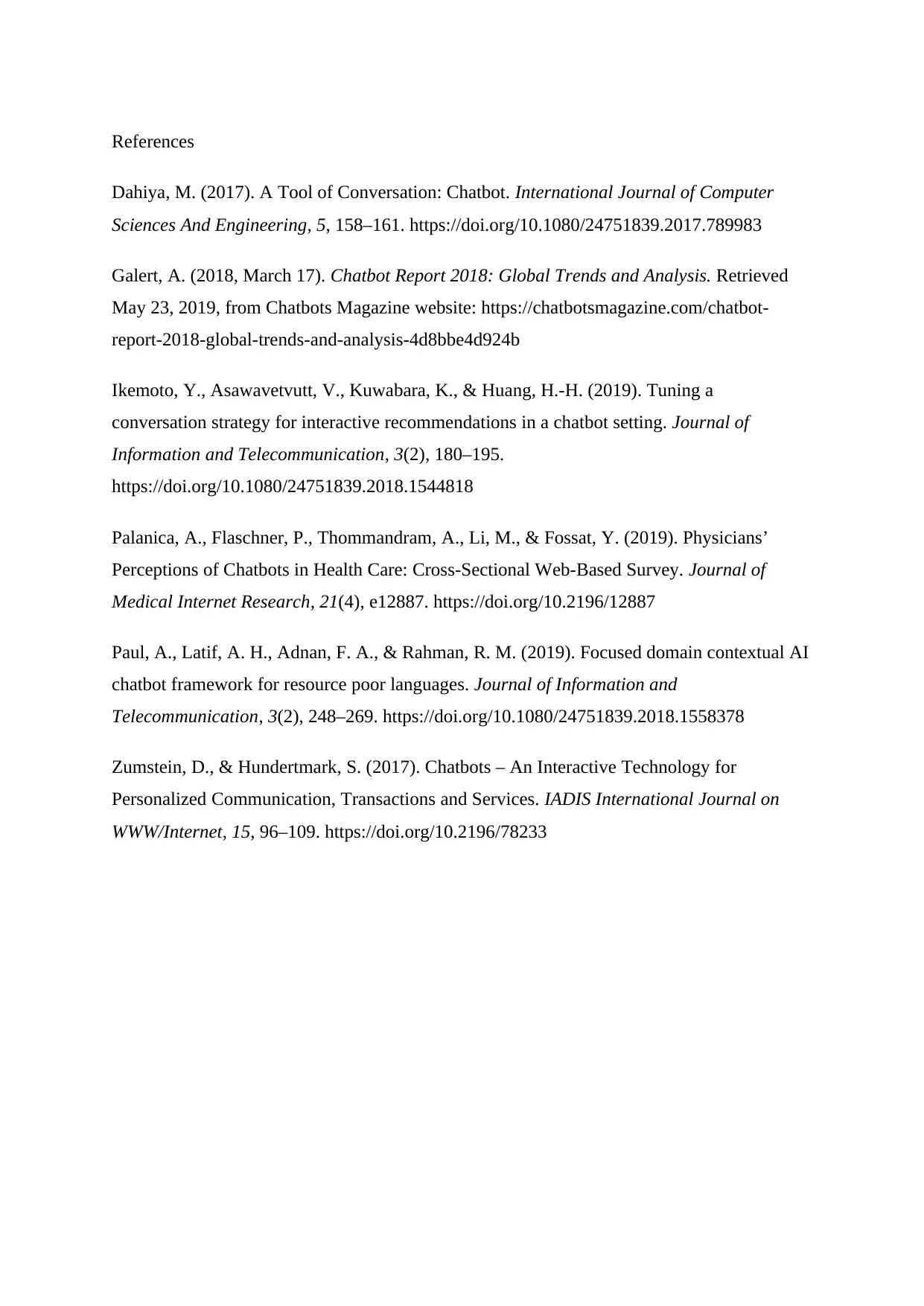Literature Review: Chatbot Development, Applications, and Trends
VerifiedAdded on 2023/01/19
|5
|1081
|93
Literature Review
AI Summary
This literature review explores the evolution and application of chatbots, focusing on their impact on the retail industry and customer interaction. It delves into the different types of chatbots, including support, skills, and assistant bots, highlighting their functionalities and specific uses. The review examines the role of AI, natural language processing, and machine learning in chatbot development, emphasizing the importance of creating user-friendly interfaces and personalized solutions. It also discusses the challenges and successes of implementing chatbots, emphasizing the need for robust training data and a personality that aligns with brand values. References to key studies and insights are provided, offering a comprehensive overview of the current state and future potential of chatbot technology in various business contexts.

Literature Review: Chat-bot
Student’s name
Institution Affiliation(s)
Student’s name
Institution Affiliation(s)
Paraphrase This Document
Need a fresh take? Get an instant paraphrase of this document with our AI Paraphraser

Chat-bot
Retailers today have to keep up with changing customer tastes. Our preferences are
evolving with the technology that shapes our needs. The tides of artificial intelligence (AI)
have brought new forms of innovations to the shores of the retail industry. Chat-bots is one
form of innovation contributed by AI. In its capacity, chat-bots are designed to recreate
human-like behaviour to seamlessly facilitate human and computer interaction. Consumers
have started becoming accustomed to the functionalities of chat-bots through online
interfaces (Ikemoto, Asawavetvutt, Kuwabara, & Huang, 2019).
It is important to denote the different forms in which chat-bots exist. The technology,
using natural language processing and machine learning, has been gathering momentum for a
few years now. Conversational chat-bots became a popular form that was widely getting
accepted in the market and spurred competition among organizations that looked to acquire a
competitive advantage by deploying its capabilities. From a branding perspective, companies
used the idea of “virtual assistants” to differentiate themselves, largely overlooking the
underlying mechanics and shifting focus on being able to solve business problems. Bots,
therefore, became a universal term for businesses, adopted on the basis of fashion technology.
However, different variations of bots are programmed to solve particular problems. The
following paragraph explores the three principal forms of bots used in a business context
(Palanica et al., 2019).
IBM Watson is renowned for its contributions to businesses in the AI space. The first
type of bot in question is support chat-bots, built to become proficient within a specific
domain. These bots possess a personality which is geared towards building knowledge about
a particular topic, for example, knowledge about company policies. They are capable of
understanding business processes and respond effectively to questions that genuinely appear
in FAQ sections. It is essential to have support chat-bots in short and long tail versions (Paul,
Retailers today have to keep up with changing customer tastes. Our preferences are
evolving with the technology that shapes our needs. The tides of artificial intelligence (AI)
have brought new forms of innovations to the shores of the retail industry. Chat-bots is one
form of innovation contributed by AI. In its capacity, chat-bots are designed to recreate
human-like behaviour to seamlessly facilitate human and computer interaction. Consumers
have started becoming accustomed to the functionalities of chat-bots through online
interfaces (Ikemoto, Asawavetvutt, Kuwabara, & Huang, 2019).
It is important to denote the different forms in which chat-bots exist. The technology,
using natural language processing and machine learning, has been gathering momentum for a
few years now. Conversational chat-bots became a popular form that was widely getting
accepted in the market and spurred competition among organizations that looked to acquire a
competitive advantage by deploying its capabilities. From a branding perspective, companies
used the idea of “virtual assistants” to differentiate themselves, largely overlooking the
underlying mechanics and shifting focus on being able to solve business problems. Bots,
therefore, became a universal term for businesses, adopted on the basis of fashion technology.
However, different variations of bots are programmed to solve particular problems. The
following paragraph explores the three principal forms of bots used in a business context
(Palanica et al., 2019).
IBM Watson is renowned for its contributions to businesses in the AI space. The first
type of bot in question is support chat-bots, built to become proficient within a specific
domain. These bots possess a personality which is geared towards building knowledge about
a particular topic, for example, knowledge about company policies. They are capable of
understanding business processes and respond effectively to questions that genuinely appear
in FAQ sections. It is essential to have support chat-bots in short and long tail versions (Paul,

Latif, Adnan, & Rahman, 2019). The former is often used for responding to common
questions and guiding mundane processes. The latter analyzes a multitude of situations to
reach optimal solutions. One of the key points that a developer should focus on when making
a support chat-bot is ensuring that the correct functions are in place to ease navigation and
solve issues relevant to users (Zumstein & Hundertmark, 2017).
The second form of chat-bots is known as skills chat-bots. From a functional
standpoint, these bots are programmed with a narrower focus with pre-set commands,
requiring little to no contextual data. For example, users may instruct a bot to change the light
settings of his or her room. In this case, the user interface is more simplistic such as voice
command, as the bot is able to execute instructions at ease. Users are, therefore, not required
to go through the process of turning on their device and location touch points to activate the
bot. Skills chat-bots functionalities allow users to multitask while they are engaging with the
platform. It is possible to enhance the functionalities of these bots, as they can be
programmed to provide personalized solutions depending on the location of the user.
Integration of the skills chat-bot is key, especially when being used at home or for personal
belongings that can be compounded to voice command instructions (Galert, 2018).
The third form of chat-bots is called assistant chat-bots. These bots sit at the
intersection of the two aforementioned bots. Assistant bots function best specializing little
across a wide range of functions, almost taking the role of an office secretary. The secretary
is the intermediary who sets up meetings with all types of departments and connects you to a
multitude of people and business cases. Siri is a prime example of assistant chat-bots, which
is both conversational and appealing in character. The nature of these conversations can keep
one entertained even if the bot is unable to execute all instructions inputted by the user
(Dahiya, 2017).
questions and guiding mundane processes. The latter analyzes a multitude of situations to
reach optimal solutions. One of the key points that a developer should focus on when making
a support chat-bot is ensuring that the correct functions are in place to ease navigation and
solve issues relevant to users (Zumstein & Hundertmark, 2017).
The second form of chat-bots is known as skills chat-bots. From a functional
standpoint, these bots are programmed with a narrower focus with pre-set commands,
requiring little to no contextual data. For example, users may instruct a bot to change the light
settings of his or her room. In this case, the user interface is more simplistic such as voice
command, as the bot is able to execute instructions at ease. Users are, therefore, not required
to go through the process of turning on their device and location touch points to activate the
bot. Skills chat-bots functionalities allow users to multitask while they are engaging with the
platform. It is possible to enhance the functionalities of these bots, as they can be
programmed to provide personalized solutions depending on the location of the user.
Integration of the skills chat-bot is key, especially when being used at home or for personal
belongings that can be compounded to voice command instructions (Galert, 2018).
The third form of chat-bots is called assistant chat-bots. These bots sit at the
intersection of the two aforementioned bots. Assistant bots function best specializing little
across a wide range of functions, almost taking the role of an office secretary. The secretary
is the intermediary who sets up meetings with all types of departments and connects you to a
multitude of people and business cases. Siri is a prime example of assistant chat-bots, which
is both conversational and appealing in character. The nature of these conversations can keep
one entertained even if the bot is unable to execute all instructions inputted by the user
(Dahiya, 2017).
⊘ This is a preview!⊘
Do you want full access?
Subscribe today to unlock all pages.

Trusted by 1+ million students worldwide

In conclusion, the key to achieving success with an assistant bot is able to test its
capabilities with an adequate training set of data. Given the interactive nature of assistant
bots, users are likely to ask questions that span beyond its programmed knowledge.
Responses can often lack accuracy. Chat-bots are remodeling customer shopping experiences
in the e-commerce space as they keep engaging with users. It comes down to the retailer
themselves to give their bots a personality that represents their brand values.
capabilities with an adequate training set of data. Given the interactive nature of assistant
bots, users are likely to ask questions that span beyond its programmed knowledge.
Responses can often lack accuracy. Chat-bots are remodeling customer shopping experiences
in the e-commerce space as they keep engaging with users. It comes down to the retailer
themselves to give their bots a personality that represents their brand values.
Paraphrase This Document
Need a fresh take? Get an instant paraphrase of this document with our AI Paraphraser

References
Dahiya, M. (2017). A Tool of Conversation: Chatbot. International Journal of Computer
Sciences And Engineering, 5, 158–161. https://doi.org/10.1080/24751839.2017.789983
Galert, A. (2018, March 17). Chatbot Report 2018: Global Trends and Analysis. Retrieved
May 23, 2019, from Chatbots Magazine website: https://chatbotsmagazine.com/chatbot-
report-2018-global-trends-and-analysis-4d8bbe4d924b
Ikemoto, Y., Asawavetvutt, V., Kuwabara, K., & Huang, H.-H. (2019). Tuning a
conversation strategy for interactive recommendations in a chatbot setting. Journal of
Information and Telecommunication, 3(2), 180–195.
https://doi.org/10.1080/24751839.2018.1544818
Palanica, A., Flaschner, P., Thommandram, A., Li, M., & Fossat, Y. (2019). Physicians’
Perceptions of Chatbots in Health Care: Cross-Sectional Web-Based Survey. Journal of
Medical Internet Research, 21(4), e12887. https://doi.org/10.2196/12887
Paul, A., Latif, A. H., Adnan, F. A., & Rahman, R. M. (2019). Focused domain contextual AI
chatbot framework for resource poor languages. Journal of Information and
Telecommunication, 3(2), 248–269. https://doi.org/10.1080/24751839.2018.1558378
Zumstein, D., & Hundertmark, S. (2017). Chatbots – An Interactive Technology for
Personalized Communication, Transactions and Services. IADIS International Journal on
WWW/Internet, 15, 96–109. https://doi.org/10.2196/78233
Dahiya, M. (2017). A Tool of Conversation: Chatbot. International Journal of Computer
Sciences And Engineering, 5, 158–161. https://doi.org/10.1080/24751839.2017.789983
Galert, A. (2018, March 17). Chatbot Report 2018: Global Trends and Analysis. Retrieved
May 23, 2019, from Chatbots Magazine website: https://chatbotsmagazine.com/chatbot-
report-2018-global-trends-and-analysis-4d8bbe4d924b
Ikemoto, Y., Asawavetvutt, V., Kuwabara, K., & Huang, H.-H. (2019). Tuning a
conversation strategy for interactive recommendations in a chatbot setting. Journal of
Information and Telecommunication, 3(2), 180–195.
https://doi.org/10.1080/24751839.2018.1544818
Palanica, A., Flaschner, P., Thommandram, A., Li, M., & Fossat, Y. (2019). Physicians’
Perceptions of Chatbots in Health Care: Cross-Sectional Web-Based Survey. Journal of
Medical Internet Research, 21(4), e12887. https://doi.org/10.2196/12887
Paul, A., Latif, A. H., Adnan, F. A., & Rahman, R. M. (2019). Focused domain contextual AI
chatbot framework for resource poor languages. Journal of Information and
Telecommunication, 3(2), 248–269. https://doi.org/10.1080/24751839.2018.1558378
Zumstein, D., & Hundertmark, S. (2017). Chatbots – An Interactive Technology for
Personalized Communication, Transactions and Services. IADIS International Journal on
WWW/Internet, 15, 96–109. https://doi.org/10.2196/78233
1 out of 5
Related Documents
Your All-in-One AI-Powered Toolkit for Academic Success.
+13062052269
info@desklib.com
Available 24*7 on WhatsApp / Email
![[object Object]](/_next/static/media/star-bottom.7253800d.svg)
Unlock your academic potential
Copyright © 2020–2025 A2Z Services. All Rights Reserved. Developed and managed by ZUCOL.





